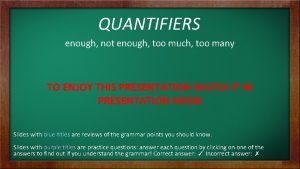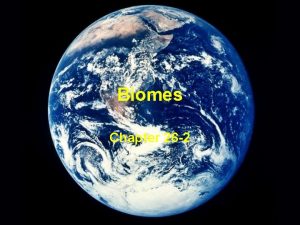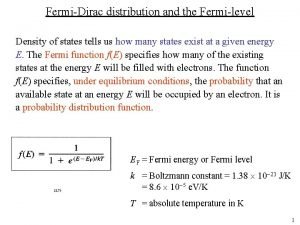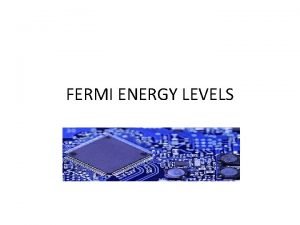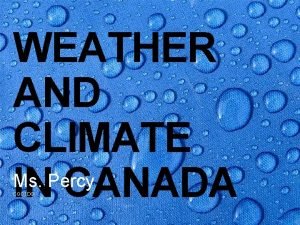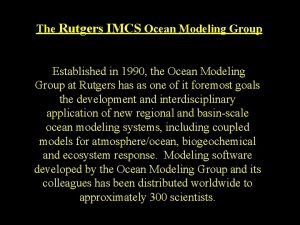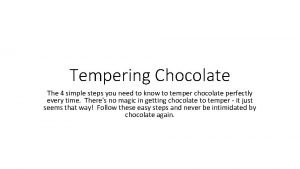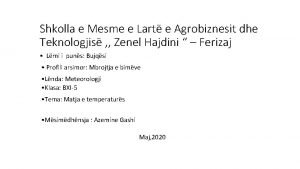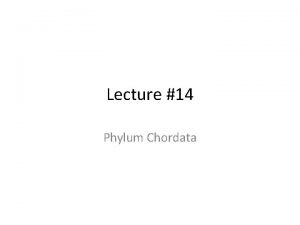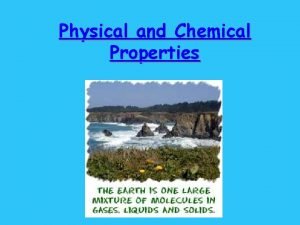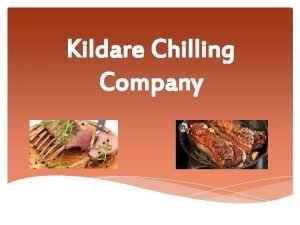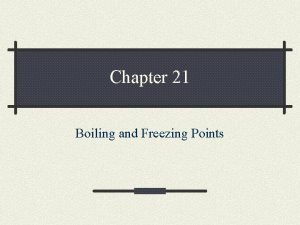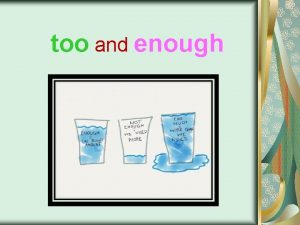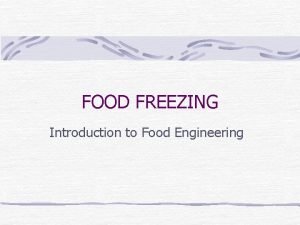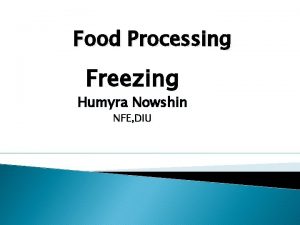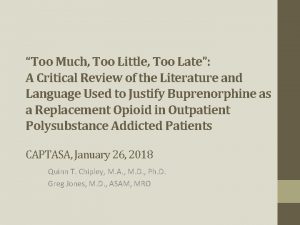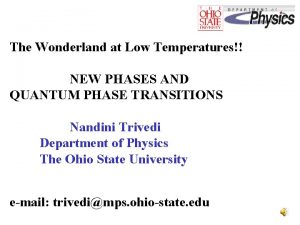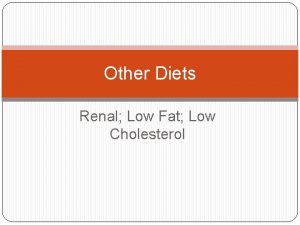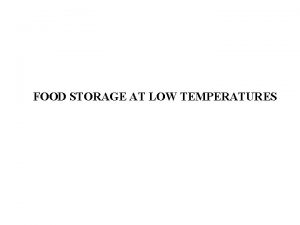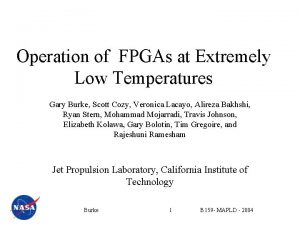CHILLING AND FREEZING Chilling temperatures are too low




























- Slides: 28

CHILLING AND FREEZING

• Chilling temperatures are too low for normal growth but not low enough for ice to form. • Typically, tropical and subtropical species are susceptible to chilling injury. Examples of susceptible crops and ornamentals. • maize, Phaseolus bean, rice, tomato, cucumber, sweet potato, and cotton • Passiflora, Coleus, and Gloxinia are examples of susceptible

chilling injury • When plants growing at relatively warm temperatures • (25 to 35°C) are cooled to 10 to 15°C, chilling injury occurs: • Growth is slowed, • Discoloration or lesions appear on leaves • The foliage looks soggy, as if soaked in water for a long time. • If roots are chilled, the plants may wilt.

Freezing injury • Freezing injury, on the other hand, occurs at temperatures below the freezing point of water. • Full induction of tolerance to freezing, as with chilling, requires a period of acclimation at cold temperatures.

Membrane Properties in Response to Chilling Injury Leaves from plants injured by chilling show • inhibition of photosynthesis, • slower carbohydrate translocation • Lower respiration rates, • Inhibition of protein synthesis • Increased degradation of existing proteins. • All of these responses appear to depend on a common primary mechanism involving loss of membrane function during chilling.

• For instance, solutes leak from the leaves of chilling sensitive Passiflora maliformis (conch apple) floated on water at 0°C, but not from those of chilling-resistant Passiflora caerulea (passion flower). Loss of solutes to the water reflects damage to the plasma membrane and possibly also to the tonoplast. • In turn, inhibition of photosynthesis and of respiration reflects injury to chloroplast and mitochondrial membranes.

Why are membranes affected by chilling? • The lipids in the bilayer have a high percentage of saturated fatty acid chains, and membranes with this composition tend to solidify into semicrystalline state at a temperature well above 0°C. • As the membranes become less fluid, their protein components can no longer function normally. The result is inhibition of H+-ATPase activity, of solute transport into and out of cells, of energy transduction and of enzyme-dependent metabolism. .

• In addition, chilling-sensitive leaves exposed to high photon fluxes and chilling temperatures are photoinhibited, causing acute damage to the photosynthetic machinery. • Membrane lipids from chilling-resistant plants often have a greater proportion of unsaturated fatty acids than those from chilling-sensitive plants.

• Acclimation to cool temperatures the activity of desaturase enzymes increases and the proportion of unsaturated lipids rises • This modification lowers the temperature at which the membrane lipids begin a gradual phase change from fluid to semicrystalline and allows membranes to remain fluid at lower temperatures.

Fatty acid composition of mitochondria isolated from chilling-resistant and chilling-sensitive species Chilling-resistant species Chilling-sensitive species Caulif Turnip lower root bud Pea shoot Bean shoot Sweet potato Maize shoot 3. 8 2. 8 1. 7 2. 1 Ratio of 3. 2 unsaturated to saturated fatty acids 3. 9

Ice Crystal Formation and Protoplast Dehydration Kill Cells • The ability to tolerate freezing temperatures under natural conditions varies greatly among tissues. • Seeds, other partly dehydrated tissues, and fungal spores can be kept indefinitely at temperatures near absolute zero (0 K or – 273°C), indicating that these very low temperatures are not intrinsically harmful.

• Fully hydrated, vegetative cells can also retain viability if they are cooled very quickly to avoid the formation of large, slow-growing ice crystals that would puncture and destroy subcellular structures. Ice crystals that form during very rapid freezing are too small to cause mechanical damage. • Conversely, rapid warming of frozen tissue is required to prevent the growth of small ice crystals into crystals of a damaging size, or to prevent loss of water vapor by sublimation, both of which take place at intermediate temperatures (– 100 to – 10°C).

• Under natural conditions, cooling of intact, multicellular plant organs is never fast enough to limit crystal formation in fully hydrated cells to only small, harmless ice crystals. • Ice usually forms first within the intercellular spaces, and in the xylem vessels, along which the ice can quickly propagate. This ice formation is not lethal to hardy plants, and the tissue recovers fully if warmed.

• However, when plants are exposed to freezing temperatures for an extended period, the growth of extracellular ice crystals results in the movement of liquid water from the protoplast to the extracellular ice, causing excessive dehydration

ice nucleation • During rapid freezing, the protoplast, including the vacuole, supercools; • that is, the cellular water remains liquid even at temperatures several degrees below its theoretical freezing point. Several hundred molecules are needed for an ice crystal to begin forming. The process whereby these hundreds of water molecules start to form a stable ice crystal is called ice nucleation, and it strongly depends on the properties of the involved surfaces. Some large polysaccharides and proteins facilitate ice crystal formation and are called ice nucleators.

• Some ice nucleation proteins made by bacteria appear to facilitate ice nucleation by aligning water molecules along repeated amino acid domains within the protein. • In plant cells, ice crystals begin to grow from endogenous ice nucleators, and the resulting, relatively large intracellular ice crystals cause extensive damage to the cell and are usually lethal.

antifreeze proteins • Several specialized plant proteins may help limit the growth of ice crystals by a noncolligative mechanism—that is, an effect that does no depend on the lowering of the freezing point of water by the presence of solutes. These antifreeze proteins are induced by cold temperatures, and they bind to the surfaces of ice crystals to prevent or slow further crystal growth.

Cryoprotective Agents • Sugars and some of the cold-induced proteins are suspected to have (cryo- = “cold”) effects; they stabilize proteins and membranes during dehydration induced by low temperature. • Sucrose predominates among the soluble sugars associated with freezing tolerance that function in a colligative fashion, but in some specie raffinose, fructans, sorbitol, or mannitol serves the same function. • During cold acclimation of winter cereals, soluble sugars accumulate in the cell walls, where they may help restrict the growth of ice. A cryoprotective glycoprotein has been isolated from leaves of coldacclimated cabbage

Some Woody Plants Can Acclimate to Very Low Temperatures • Native species of Prunus (cherry, plum, and other pit fruits) from northern cooler climates in North America are hardier after acclimation than those from milder climates.

Under natural conditions, woody species acclimate to cold in two distinct stages • In the first stage, hardening is induced in the early autumn by exposure to short days and nonfreezingchilling temperatures both of which combine to stop growth. A diffusible factor that promotes acclimation (probably ABA) moves in the phloem from leaves to overwintering stems and may be responsible for the changes. During this period, woody specie also withdraw water from the xylem vessels, thereby preventing the stem from splitting in response to the expansion of water during later freezing. Cells in this first stage of acclimation can survive temperatures well below 0°C, but they are not fully hardened. • In the second stage, direct exposure to freezing is the stimulus; no known translocatable factor can confer the hardening resulting from exposure to freezing. When fully hardened, the cells can tolerate exposure to temperatures of – 50 to – 100°C.

Some Bacteria That Live on Leaf Surfaces Increase Frost Damage • When leaves are cooled to temperatures in the – 3 to – 5°C range, the formation of ice crystals on the surface (frost) is accelerated by certain bacteria that naturally inhabit the leaf surface • Act as ice nucleators. Examples • Pseudomonas syringae • Erwinia herbicola

• Bacterial strains can be genetically modified so that they lose their ice-nucleating characteristics. Such strains have been used commercially in foliar sprays of valuable frostsensitive crops like strawberry to compete with native bacterial strains and thus minimize the number of potential ice nucleation points.

ABA and Protein Synthesis Are Involved in Acclimation to Freezing • Many genes/Proteins induced by freezing are same as induced by ABA under nonacclimatin conditions. • homology with the RAB/LEA/DHN (responsive to ABA, late embryo abundant, and dehydrin. • Plants hardened by water shortages, the freezing tolerance also increases.

Numerous Genes Are Induced during Cold Acclimation • Expression of certain genes and synthesis of specific proteins are common to both heat and cold stress, but some aspects of cold-inducible gene expression differ from that produced by heat stress. Proteins Induced • heat shock proteins that can act as molecular chaperones

• antifreeze proteins. Antifreeze proteins confer to aqueous solutions the property of thermal hysteresis (transition from liquid to solid is promoted at a lower temperature than is transition from solid to liquid), and thus they are sometimes referred to as thermal hysteresis proteins (THPs

• Several types of cold-induced, antifreeze proteins have been discovered in cold-acclimated winterhardy monocots. • When the specific genes coding for these proteins were cloned and sequenced, it was found that all antifreeze proteins belong to a class of proteins such as endochitinases and endoglucanases, which are induced upon infection of different pathogens. These proteins called pathogenesis related (PR) proteins are thought to protect plants against pathogens.

• It thus appears that at least in monocots, the dual role of these proteins as antifreeze and pathogenesisrelated proteins might protect plant cells against both cold stress and pathogen attack. • proteins involved in the synthesis of osmolyte. • proteins for membrane stabilization • the LEA proteins.

A Transcription Factor Regulates Cold-Induced Gene Expression • More than 100 genes are up-regulated by cold stress. • CBF/DREB 1 -type transcription factors bind to. CRT/DRE elements (Crepeat/dehydration-responsive, ABAindependent sequence elements) in gene promoter sequences. • The expression of CBF 1/DREB 1 b is controlled by a separate transcription factor, called ICE (inducer of CBF expression).
 Insidan region jh
Insidan region jh Kahoot enough too
Kahoot enough too Cool treeless and dry
Cool treeless and dry Too broad and too narrow examples
Too broad and too narrow examples Rational of the study
Rational of the study Too broad and too narrow examples
Too broad and too narrow examples Being too broad
Being too broad Högkonjuktur inflation
Högkonjuktur inflation Just right scale
Just right scale Too foreign for here too foreign for home
Too foreign for here too foreign for home Too anointed to be disappointed meaning
Too anointed to be disappointed meaning Emotive style communication
Emotive style communication Mid low high
Mid low high High precision vs high accuracy
High precision vs high accuracy Low voltage hazards
Low voltage hazards What information should a master cleaning schedule contain
What information should a master cleaning schedule contain Fermi dirac distribution function tells
Fermi dirac distribution function tells Fermi-dirac distribution function at different temperatures
Fermi-dirac distribution function at different temperatures Fermi function
Fermi function Law of intermediate temperatures
Law of intermediate temperatures Canada heat wave temperatures
Canada heat wave temperatures Rutgers water temp
Rutgers water temp Tempering chocolate temperatures chart celsius
Tempering chocolate temperatures chart celsius Instrumenti per matjen e temperatures se ajrit
Instrumenti per matjen e temperatures se ajrit Which chordate groups can regulate their body temperatures
Which chordate groups can regulate their body temperatures Hardness texture color and freezing point are examples of
Hardness texture color and freezing point are examples of Market forms of poultry drawing
Market forms of poultry drawing Who owns kildare chilling
Who owns kildare chilling Infinitively
Infinitively

